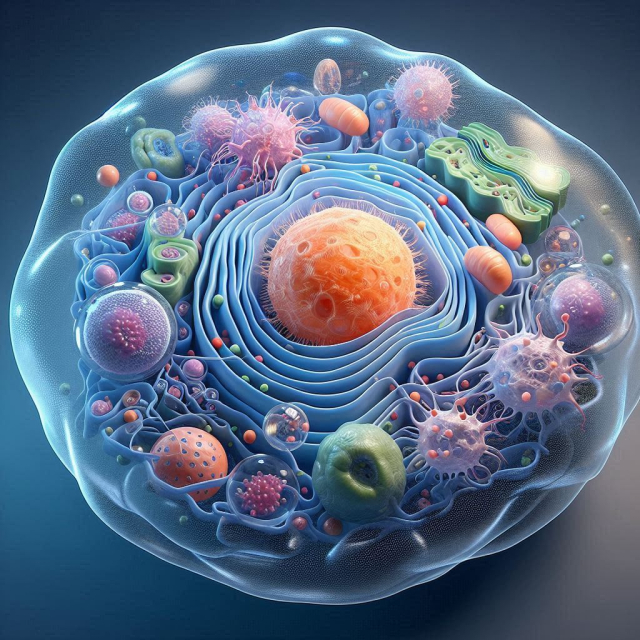Cells are the basic unit of life in all living organisms. From tiny bacteria to complex humans, all life forms are made of cells. These microscopic structures are responsible for carrying out all the functions necessary for life, from metabolism to reproduction. In this article, we will explore in depth cells, their structure, types, functions and the importance of their study in biology and medicine.
Cell Structure.
Main components.
Cells, although varied in form and function, share certain basic components. Eukaryotic cells, which include animal and plant cells, have a complex structure with several organelles, while prokaryotic cells, such as bacteria, are simpler.
Cellular membrane.
The cell membrane is a semipermeable structure that surrounds the cell, controlling the passage of substances into and out of the cell. It is mainly composed of a phospholipid bilayer with embedded proteins, which perform various functions, such as molecule transport and cellular communication.
Cytoplasm.
Cytoplasm is the gelatinous material that fills the interior of the cell, where the organelles are suspended. It is composed mainly of water, salts, and various organic molecules.
Core.
The nucleus is the largest organelle in eukaryotic cells and contains the cell's genetic material, DNA. It is surrounded by a double membrane known as the nuclear envelope and contains the nucleolus, where ribosomes are assembled.
Organelles.
Eukaryotic cells contain several organelles, each with specific functions. Ribosomes are responsible for protein synthesis. Mitochondria, known as the powerhouses of the cell, produce ATP through cellular respiration. The endoplasmic reticulum and Golgi apparatus are involved in the synthesis and transport of proteins and lipids. Lysosomes contain digestive enzymes that break down macromolecules and cellular debris.
Differences between Animal and Plant Cells.
Although they share many components, animal and plant cells have key differences. Plant cells have a rigid cell wall that gives them support and shape. They also contain chloroplasts, which carry out photosynthesis, and large central vacuoles that store water and nutrients.
Cell types.
Prokaryotic cells.
Prokaryotic cells are the simplest and oldest forms of life. They lack a defined nucleus and other membranous organelles. Its genetic material is dispersed in the cytoplasm in a region called the nucleoid. Bacteria and archaea are examples of prokaryotic organisms. These cells are extremely diverse and can inhabit a wide range of environments.
Eukaryotic cells.
Eukaryotic cells are more complex and are found in organisms such as animals, plants, fungi and protists. They have a defined nucleus and several membranous organelles that perform specific functions. The complexity of eukaryotic cells allows for greater specialization and differentiation of tissues and organs.
Specialized Cells.
In multicellular organisms, cells specialize to perform specific functions. For example, neurons transmit electrical signals in the nervous system, muscle cells facilitate movement, and epithelial cells form protective barriers. Cellular differentiation allows organisms to perform complex tasks and adapt to different environments.
Functions of Cells.
Metabolism.
Cells carry out all the chemical reactions necessary to sustain life, known collectively as metabolism. This includes the catalysis of reactions that break down nutrients for energy (catabolism) and the synthesis of molecules necessary for cell construction and repair (anabolism).
Reproduction.
Cells have the ability to reproduce, which is essential for the growth and repair of organisms. Prokaryotic cells reproduce primarily by binary fission, a simple process in which the cell divides into two identical daughter cells. Eukaryotic cells divide through mitosis (for growth and repair) or meiosis (for the production of gametes in sexual reproduction).
Cellular Communication.
Cells communicate with each other using chemical and electrical signals. This communication is crucial for the coordination of functions in multicellular organisms. Hormones, neurotransmitters and other signaling molecules transmit information between cells, allowing coordinated responses to internal and external stimuli.
Transport of Substances.
Cells need to transport substances in and out of their membrane to maintain homeostasis. This transport can be passive (does not require energy) or active (requires energy). Channels and pumps in the cell membrane regulate the passage of ions and molecules, ensuring that cells maintain a proper balance of nutrients and wastes.
Importance of the Study of Cells.
Medicine and health.
The study of cells is fundamental for medicine and health. Understanding how cells work and what makes them sick is key to developing treatments and cures for diseases. For example, cellular research has led to the development of cancer therapies, where knowledge of how cancer cells divide has allowed the design of drugs that inhibit their proliferation.
Biotechnology.
Biotechnology is based on the use of cells and their components to develop useful products and technologies. Genetic engineering, for example, uses techniques to modify the DNA of cells to produce organisms with desired characteristics, such as pest-resistant plants or bacteria that produce drugs.
Agriculture.
Knowledge of cell biology is crucial for modern agriculture. Advances in biotechnology have made it possible to develop genetically modified crops that are more resistant to diseases, pests and adverse environmental conditions. This has improved the productivity and sustainability of agriculture.
Ecology and Conservation .
The study of cells also has implications in ecology and conservation. Understanding how cells respond to environmental changes and pollution can help develop strategies to protect ecosystems and endangered species.
Cells are the cornerstone of life. Their study has revolutionized our understanding of biology and has had a profound impact on multiple fields, from medicine to agriculture. As we advance cellular research, we continue to uncover the complex mechanisms that govern life and develop new technologies to improve human health and the sustainability of the planet. Cell biology will continue to be a vital area of science, with the potential to offer solutions to some of humanity's most pressing challenges.
